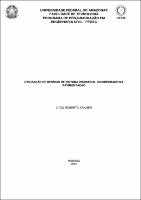| ???jsp.display-item.social.title??? |


|
Please use this identifier to cite or link to this item:
https://tede.ufam.edu.br/handle/tede/6013| ???metadata.dc.type???: | Dissertação |
| Title: | Utilização de resíduo de pintura industrial incorporado na pavimentação |
| ???metadata.dc.creator???: | Kramer, Ilton Roberto  |
| ???metadata.dc.contributor.advisor1???: | Vieira, Raimundo Kennedy |
| ???metadata.dc.description.resumo???: | A implantação e operação de planta de pintura industrial em Porto Velho, trouxe como conseqüência a geração de resíduos de complexidade e valor compatíveis com a composição dos revestimentos aplicados no processo. Entretanto o reuso desse material esteve fora de cogitação pela indústria que passou a descartá-lo como lixo. Este trabalho tem por objetivo gerar alternativas para reutilização do resíduo em questão na pavimentação local. A utilização de material residual sólido do setor de pintura industrial e material não convencional na mistura asfáltica, foi avaliada em substituição aos elementos tradicionais na camada do revestimento. Para tanto, utilizou-se o resíduo gerado no setor de pintura industrial de equipamentos hidromecânicos e de levantamento das usinas hidrelétricas na cidade de Porto Velho/RO. A Indústria Metalúrgica e Mecânica da Amazônia (IMMA) é a responsável pela construção completa e instalação dos equipamentos hidromecânicos das UHE Santo Antonio e UHE Jirau, instaladas na localidade de Porto Velho. Atualmente, estes resíduos são destinados para depósito em aterro sanitário no estado de Mato Grosso, ocasionando prejuízos ao meio ambiente e para a própria indústria metalúrgica. O resíduo de pintura industrial foi utilizado como agregado miúdo no concreto asfáltico usinado a quente (CBUQ), em substituição ao material tradicionalmente usado nesta região, ou seja, a areia de jazida. Foi feita uma análise comparativa entre as misturas betuminosas, convencional e alternativa, com os dois tipos de agregados miúdos, utilizando o mesmo teor ótimo da mistura com o CAP-50/70. Foram moldados corpos de prova de CBUQ e analisados os resultados concernentes à estabilidade Marshall, fluência a 60ºC. Os resultados dos ensaios mostram que é possível adicionar 15% da mistura confeccionada com o resíduo de pintura industrial como agregado miúdo,sem alterar as propriedades mecânicas do pavimento comparado à mistura convencional, confeccionada com areia. |
| Abstract: | The implantation and operation of an industrial painting plant in Porto Velho resulted in the generation of residues of complexity and value compatible with the composition of the coatings applied in the process. However, the reuse of this material was out of the question by the industry, which discarded it as waste. This work aims to generate alternatives for the reuse of the waste in question in the local paving. The use of solid residual material from the industrial paint sector and unconventional material in the asphalt mixture was evaluated instead of the traditional elements in the coating layer. For that, the residue generated in the industrial painting sector of hydro mechanical equipment and the survey of the hydroelectric plants in the city of Porto Velho / RO was used. The Metallurgical and Mechanical Industry of the Amazon (IMMA) is responsible for the complete construction and installation of hydro mechanical equipment of the Santo Antonio HPP and Jirau HPP, installed in the town of Porto Velho. Currently, these wastes are destined to landfill in the state of Mato Grosso, causing damages to the environment and to the metallurgical industry itself. The industrial paint residue was used as a small aggregate in the hot-rolled asphalt concrete (CBUQ), replacing the material traditionally used in this region, that is, the sand of the deposit. A comparative analysis was performed between the conventional and alternative bituminous mixtures with the two types of small aggregates using the same optimum content of the mixture with the CAP-50/70. CBUQ test specimens were cast and the results concerning Marshall stability, flow at 60 ° C, were analyzed. The results of the tests show that it is possible to add 15% of the mixture made with the industrial paint residue as a small aggregate without altering the mechanical properties of the pavement compared to the conventional mixture made with sand. |
| Keywords: | Pavimentação Resíduos sólidos Asfalto |
| ???metadata.dc.subject.cnpq???: | ENGENHARIAS: ENGENHARIA CIVIL |
| Language: | por |
| ???metadata.dc.publisher.country???: | Brasil |
| Publisher: | Universidade Federal do Amazonas |
| ???metadata.dc.publisher.initials???: | UFAM |
| ???metadata.dc.publisher.department???: | Faculdade de Tecnologia |
| ???metadata.dc.publisher.program???: | Programa de Pós-graduação em Engenharia Civil |
| Citation: | KRAMER, Ilton Roberto. Utilização de resíduo de pintura industrial incorporado na pavimentação. 2017. 65 f. Dissertação (Mestrado em Engenharia Civil) - Universidade Federal do Amazonas, Manaus, 2017. |
| ???metadata.dc.rights???: | Acesso Aberto |
| URI: | http://tede.ufam.edu.br/handle/tede/6013 |
| Issue Date: | 11-Aug-2016 |
| Appears in Collections: | Mestrado em Engenharia Civil |
Files in This Item:
| File | Description | Size | Format | |
|---|---|---|---|---|
| Dissertação - Ilton Roberto Kramer - Dissertação.pdf | 1.44 MB | Adobe PDF |  Download/Open Preview |
Items in DSpace are protected by copyright, with all rights reserved, unless otherwise indicated.




